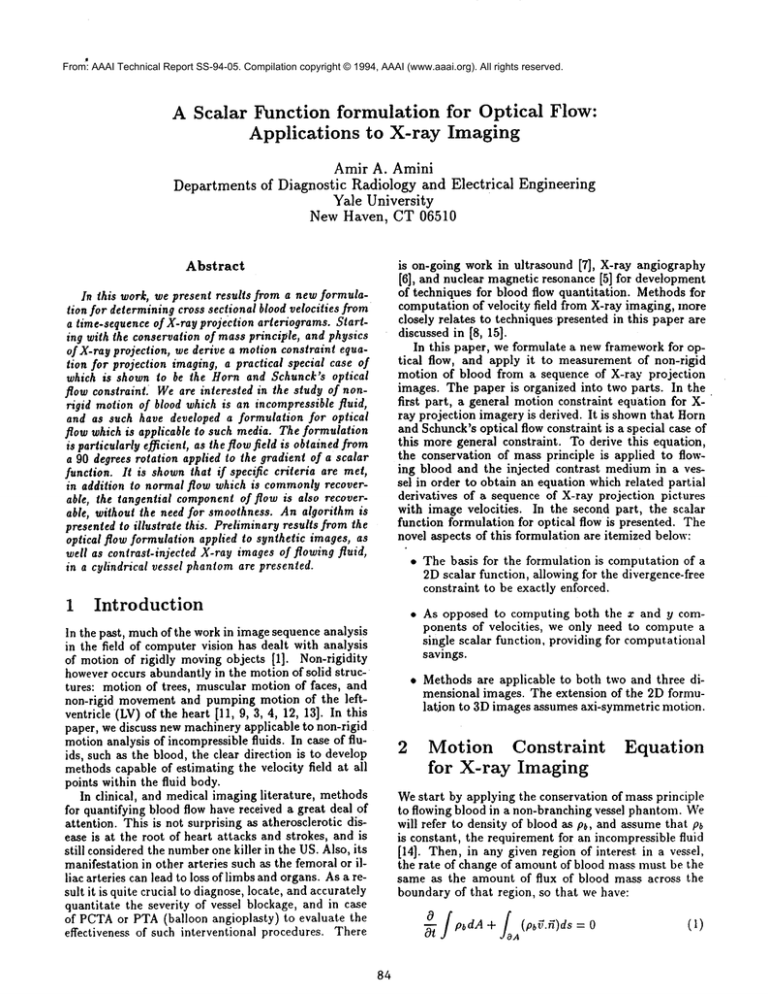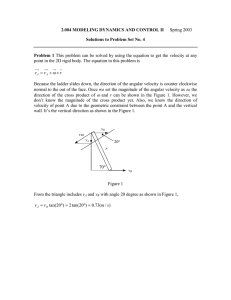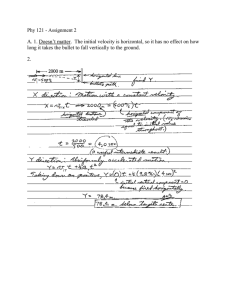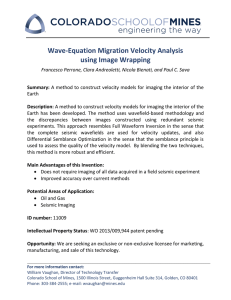
From: AAAI Technical Report SS-94-05. Compilation copyright © 1994, AAAI (www.aaai.org). All rights reserved.
A Scalar Function formulation for Optical Flow:
Applications
to X-ray Imaging
Amir A. Amini
Departments of Diagnostic Radiology and Electrical
Yale University
New Haven, CT 06510
is on-going work in ultrasound [7], X-ray angiography
[6], and nuclear magnetic resonance [5] for development
of techniques for blood flow quantitation. Methods for
computation of velocity field from X-ray imaging, more
closely relates to techniques presented in this paper are
discussed in [8, 15].
In this paper, we formulate a new framework for optical flow, and apply it to measurement of non-rigid
motion of blood from a sequence of X-ray projection
images. The paper is organized into two parts. In the
first part, a general motion constraint equation for Xray projection imagery is derived. It is shownthat Horn
and Schunck’s optical flow constraint is a special case of
this more general constraint. To derive this equation,
the conservation of mass principle is applied to flowing blood and the injected contrast mediumin a vessel in order to obtain an equation which related partial
derivatives of a sequence of X-ray projection pictures
with image velocities.
In the second part, the scalar
function formulation for optical flow is presented. The
novel aspects of this formulation are itemized below:
Abstract
In this work, we present results from a new formulation for determining cross sectional blood velocities from
a time.sequence of X-ray projection arteriograms. Starting with the conservation of mass principle, and physics
of X-ray projection, we derive a motion constraint equation for projection imaging, a practical special case of
which is shown to be the Horn and Schunck’s optical
flow constrainL Weare interested in the study of nonrigid motion of blood which is an incompressible fluid,
and as such have developed a formulation for optical
flow which is applicable to such media. The formulation
is particularly efficient, as the flow field is obtainedfrom
a 90 degrees rotation applied to the gradient of a scalar
function. It is shown that if specific criteria are met,
in addition to normal flow which is commonlyrecoverable, the tangential componentof flow is also recover.
able, without the need for smoothness. An algorithm is
presented to illustrate this. Preliminary results from the
optical flow formulation applied to synthetic images, as
well as contrast-injected X-ray images of flowing fluid,
in a cylindrical vessel phantomare presented.
1
Engineering
The basis for the formulation is computation of a
2D scalar function, allowing for the divergence-free
constraint to be exactly enforced.
Introduction
As opposed to computing both the x and y components of velocities,
we only need to compute a
single scalar function, providing for computational
savings.
In the past, muchof the work in image sequence analysis
in the field of computer vision has dealt with analysis
of motion of rigidly moving objects [1]. Non-rigidity
however occurs abundantly in the motion of solid structures: motion of trees, muscular motion of faces, and
non-rigid movement and pumping motion of the leftventricle (LV) of the heart [11, 9, 3, 4, 12, 13]. In this
paper, we discuss new machinery applicable to non-rigid
motion analysis of incompressible fluids. In case of fluids, such as the blood, the clear direction is to develop
methods capable of estimating the velocity field at all
points within the fluid body.
In clinical, and medical imaging literature, methods
for quantifying Blood flow have received a great deal of
attention. This is not surprising as atherosclerotic disease is at the root of heart attacks and strokes, and is
still considered the numberone killer in the US. Also, its
manifestation in other arteries such as the femoral or illiac arteries can lead to loss of limbs and organs. As a result it is quite crucial to diagnose, locate, and accurately
quantitate the severity of vessel Blockage, and in case
of PCTAor PTA(balloon angioplasty) to evaluate the
effectiveness of such interventional procedures. There
Methods are applicable to both two and three dimensional images. The extension of the 2D formulation to 3D images assumes axi-symmetric motion.
2
Motion Constraint
for X-ray Imaging
Equation
Westart by applying the conservation of mass principle
to flowing blood in a non-branching vessel phantom. We
will refer to density of blood as Pb, and assume that Pb
is constant, the requirement for an incompressible fluid
[14]. Then, in any given region of interest in a vessel,
the rate of change of amount of blood mass must be the
same as the amount of flux of blood mass across the
boundary of that region, so that we have:
84
where~" isthebloodvelocity,
n is normal
to theboundaryof theregion
0A,anddsisthedifferential
of length
element
alongtheboundary
of region.The secondintegralalong0A is thebloodmassflux.Uponinvoking
Gauss’s
theorem,
we havethe continuity
equation
involving
blooddensity
andbloodvelocity:
0Pb
(2)
ot + (Pb = 0
with Pb constant, the above equation simplifies to
V "v = 0
E, + uE= + vE~ = 0
(3)
which
is thecondition
forincompressibility
ofblood,
the
divergence
freeconstraint.
In X-rayimaging,
bloodwill
notbevisible
initself,
anda contrast
material
mustbe
injected
in to the bloodstreamwitha catheter
when
imaging
thevessel,
resulting
in attenuation
of theXrays.Thecontrast
velocity
willobeybloodVelocity,
6,
0pc
+ ~Z-(PcO = 0
(4)
~ince the divergence of blood velocity must be zero, the
~bove equation reduces to
Opt
(5).
=o
ot +
~ssuming monochromatic X-ray beams, for X-ray proection imaging,
{ z’
log E
~0 -= BL(I)
t~ pc(~(u))lff(u)ldu
)
(6
vhere E = E(fl(/)) is the image intensity that results
vhen one follows the actual path of an X-ray beam up
o the point fl(i) = (a:(l), g(l), z(i)), parametrizes the
(-ray beam path through the phantom, E0 denotes the
mattenuated X-rays, Pc is the mass attenuation coeffilent of contrast material and L(l) is the length of path
raversed by the beam. B is used to denote the com,ined attenuation effects in the absence of contrast maerial. Given this relationship, one can obtain the acual contrast material density at a point, assuming the
[.-ray beamtravel a straight path from a source point,
Zs, ~]s, Zs ):
((z - z,), (y -- Ys), (z - z,))
x/(x- x,)2 + (v - 2 + (z - z0)
where partial derivatives are taken with respect to
z, y, z, t; all subscripted accordingly. In addition, u,v,
and w are each functions representing the z, y, and z
componentsof ~7 at a point.
With a 2D flow approximation of 3D blood flow, w =
0. Furthermore, if we assume that on the average, the
distribution of contrast mass can be described by a 2D
function, pc(z, y, z) = pc(z, y). The following equation
is then obtained as a special case of equation (8):
(9)
describing the components of blood velocities in terms
of partial derivatives of contrast-injected pictures. Note
that the above equation is the well-known Horn and
Schunck’s optical flow constraint and related the partial
derivatives of a sequence of images at a point, with the
velocity of points on a movingobject [10]. Here, we have
showna general form of this equation for X-ray images
starting from the conservation of mass principle, and
derived (9) as a practical special case for our application.
In passing, we note that the natural extension of (9)
3-space may be directly applied to 3D imaging methods.
3
Scalar Function Formulation
The formulation is based on computing a stream function that approximately enforces a constraint of the
form given in equation (9) for the blood velocity field,
and at the same time the incompressibility condition is
readily and exactly satisfied. In 2D, one can always define a scalar function @such that the velocity field is
expressed as
where ~ is a unit vector perpendicular to the image
plane. It can easily be checked that this vector field
satisfies the divergence free property. Wewill refer to
such a function as a stream function. In 3D, a similar
function may be defined for axi-symmetric flow.
Note that in the dual problem one determines a
curl-free velocity field. Parallel to the definition of
stream function ~, which provides divergence-free velocity fields, we can define a velocity potential ~, with
= V¢
- B--
(7)
"he above equation may be substituted back into (5)
result in a general equation in terms of E, and the
omponents of the vector in the direction of the X¯ y beam emanating from the source at (x,,y,, z,).
he source can be assumed to emanate parallel beams,
1 {B + -~ } resulting in the following
v, = -.--:
quation of continuity for the intensity in terms of blood
elocities
E,E, - EE,, + (E~E, - EE=,)u
(EyEz - EE, z)V + (E~ - EE~z)w = 0
01)
The curl of F, X7 x ~70 = 0. This formulation will be
suitable for study of irrotational flow fields.
Substitution of components of (10) into equation (9)
results in the following hyperbolic PDE:
¯ ~Ev - @vEz+ E, = 0
(12)
which is a first order equation whose characteristics [2]
are the level curves of the projection pictures, E.
We can perform the following integration along a
curve C in order to invert equation (12):
/
@(~:,Y) = @0+
(~,y)
~7@.i’ds
(~o.v0)
(13)
where~0 is the value of~ at (x0, Y0) and t’is the tangent
to C. If C is a level curve of E, the above integral
(S)
85
provides an algorithm for determining the mass flux:
ds
~(x, g) = ql0 + J(~o,~o) E-’-’-~
overall effectiveness of the methodology, soon we will
be carrying out statistical testing of the velocity field
measurements against known velocities and volumetric
flow rates. Further in vitro validations of methods and
integration with MR-based flow estimation techniques
are also planned.
(14)
Along level curves which wrap around, the integral sum
in (14) must vanish. As this is very much data dependent, in general such curves will give rise to singularities
in the numerical solution.
3.1
Regularized
4
In this paper, we have presented results from a new
formulation for optical flow. The formulation is computationally efficient, as one needs to only compute a
single scalar function, with the prerequisite that either
the global curl or divergence of the flow field is identical
to zero. Wediscussed sources for numerical instabilities, and linked such behavior with wrap around of level
curves of E. In fact, along well-behaved level curves,
in principle, one can integrate the Horn and Schunck
optical flow constraint. Note that this statement has
deeper implications: that is, in addition to the normal
component of the velocity field, in the absence of bad
characteristics, the tangential componentof the velocity
field is recoverable, bypassing the aperture problem.
Solution
Since it is difficult to predict the behaviorof the level
curves, a more stable numerical algorithm will involve
a least-squares solution with an associated variational
principle for finding the stream function ~:
A(~x2x + 2R*~, + ~l~y)dxdy
(15)
so that J is minimized. The parameter A controls the
degree of smoothing, and in general is a non-negative
function of x and y.
Discretizing the above integral on the pixel grid, we
obtain a sum with central difference approximations for
partial derivatives of ~, as well as partial derivatives of
E(x, 9). Solution of the minimization problem at each
pixel is obtained by SOR[2].
As ~ can only be determined up to an additive constant, we set ~ = 0 on the lower boundary and q~ = r
on the upper boundary. The latter quantity is the total
mass flux in a given vessel with no branchings and may
be determined using (14), or with a second variational
principle involving F.
3.2
Experimental
Conclusions
References
[1] J. K. Aggarwal. Motion and time-varying imagery
- an overview. In Proceedings of the Workshop on
Visual Motion, 1986.
[2] William F. Ames. Numerical Methods for Partial
Differential Equations. Academic Press, NewYork,
1992.
[3] A. A. Amini, R. W. Curwen, R. T. Constable, and
J. C. Gore. Mr physics-based snake tracking and
dense deformations from tagged cardiac images. In
AAAl Symposium on Applications of Computer Vision to Medical Image Processing, Stanford University, Stanford, California, March21-23 1994.
Results
We have performed simulations to validate the
promise of the technique in computing velocity fields
from X-ray angiograms.
The following 2D simulation involved generating a sequence of images where all the models were identically
satisfied.
For generating synthetic data, we assumed,
qJ(x,9) = ~rr, with y E [0,Y] so that ~7 = (-~-,0).
This would be the case for example, for inviscid flow.
We also assumed, E(x,y) = -~ ¯ x(x - X), with
E [0,X] so that Et = -~7-VE = @x + $.~E.
Using central difference approximation, we then have,
E(x, y, t + At) = 2AtEt + E(x, y, t - At). With Et as
given, we generated the first few frames in the sequence
with F = 128, E0 = 4, andX = Y = 128. Note that
in this case at x = x the image gradient vanishes. The
results from the algorithm are shown in figure 1.
Wehave just begun with our in vitro experiments.
The experimental model is a latex tube with an inner
diameter of 1.27 era. X-ray angiography is performed
on a GE Advantx digital imaging system at the 6" image intensifier field, with 1024 × 1024 acquisitions at
rapid frame rates. For the experiment shown in figure
2, a pump delivered 612 ml/min of water in the continuous flow mode, and 5 ml/sec of an iodine contrast
agent was injected for 2 seconds. In order to assess the
[4] A. A. Amini and J. S. Duncan. Bending and
stretching models for lv wall motion analysis from
curves and surfaces. Image and Vision Computing,
10(6):418-430, July/August 1992.
[5] William G. Bradley. Flow phenomena in mr imaging. American Journal of Radiology, 150:983-994,
1988.
[6] A. M. Seifalian et at. Validation of a quantitative
radiographic technique to estimate pulsatile blood
flow waveforms using digital subtraction anglographic data. J. Biomedical Engineering, 13:225233, 1991.
[7] R. I. Kitney et al. 3d visualization for the study
of arterial disease and tissue characterization. In
Proc. of Computers in Cardiology, 1991.
[8] J. M. Fitzpatrick. A methodfor calculating velocity
in time dependent images based on the continuity
equation. In Proceedings of IEEE Conference on
Computer Vision and Pattern Recognition, pages
78-81, San Francisco, 1985.
86
[9] D. Goldgof, H. Lee, and T, Huang. Motion analysis
of nonrigid surfaces. In Proceedings of IEEEconference on Computer Vision and Pattern Recognition,
1988.
tO] B.K.P. Horn and B. G. Schunck. Determining optical flow. Artifical Intelligence, 1981.
¯ 1] T. Huang. Modeling, analysis, and visualization of
nonrigid object motion. In International Conference on Pattern Recognition, 1990.
2] D. Metaxas and D. Terzopoulos. Recursive estimation of shape and nonrigid motion. In IEEE
Workshop on Visual Motion, pages 306-311, 1991.
3] C. Nastar and N. Ayache. Non-rigid motion analysis in medical images: A physically based approach. In Information Processing in Medical
Imaging, pages 17-32, 1993.
4] R. Peyret and T. D. Taylor. Computational Methods for Fluid Flow. Springer-Verlag, NewYork,
1985.
5] S. M. Song and R. M. Leahy. Computation of
3d velocity fields from 3d cine-ct images of a human heart. IEEE Transactions on Medical Imaging, 10(3):295-306, 1991.
Figure 1: Sampledvelocity field overlaid on the second
picture of a simulated sequence for left translating flow.
The computed stream function is shown on the right.
Figure 2: Top: cross-sectional velocity profiles computed from 3 frames in a phantom sequence, overlaid
on the middle frame. Note that the picture is displayed
in reverse video. Bottom: The computed stream function from 3 frames is shownnext.
87





